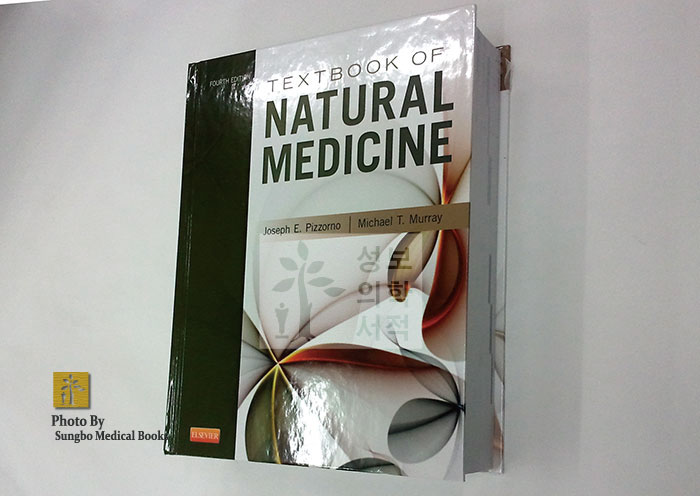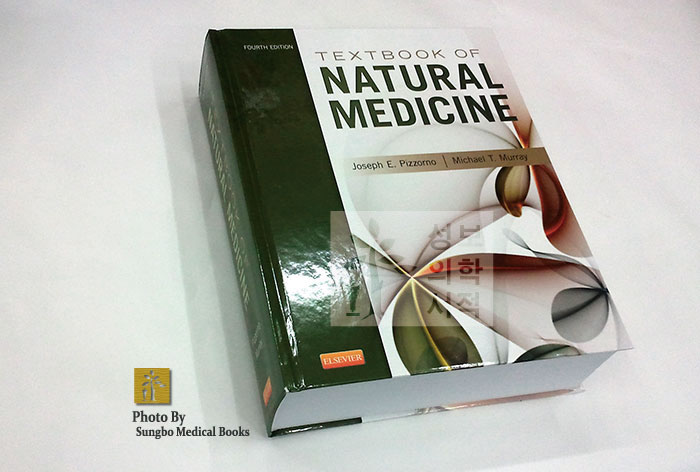Covering preventive, non-invasive, and natural treatments, Textbook of Natural Medicine, 4th Edition offers more than just alternative medicine. It promotes an integrated practice that can utilize natural medicine, traditional Western medicine, or a combination of both in a comprehensive, scientific treatment plan. Based on a combination of philosophy and clinical studies, Textbook of Natural Medicine helps you provide health care that identifies and controls the underlying causes of disease, is supportive of the body's own healing processes, and is considerate of each patient's unique biochemistry. Internationally known authors Joseph Pizzorno and Michael Murray include detailed pharmacologic information on herbs and supplements, plus evidence-based coverage of diseases and conditions to help you make accurate diagnoses and provide effective therapy.

- Contents -
INTRODUCTION
1. Eastern Origins of Integrative Medicine and Modern Applications
2. Functional Medicine: A 21st Century Model of Patient Care and Medical Education
3. A Hierarchy of Healing: The Therapeutic Order
4. History of Naturopathic Medicine
5. Philosophy of Naturopathic Medicine
6. Placebo and the Power to Heal
7. Positive Mental Attitude
8. Research in Natural Medicine
SECTION II: PHILOSOPHY OF NATURAL MEDICINE
9. Apoptosis Assessment
10. Bacterial Overgrowth of the Small Intestine Breath Test
11. Cell Signaling Analysis
12. Erythrocyte Sedimentation Rate
13. Fantus Test
14. Fatty Acid Profiling
15. Food Allergies

16. Genomics, Nutrigenomics, and the Promise of Personalized Medicine
17. Hair Mineral Analysis
18. Heidelberg pH Capsule Gastric Analysis
19. Immune Function Assessment
20. Intestinal Permeability Assessment
21. Laboratory Tests for the Determination of Vitamin Status
22. Lactose Intolerance Testing
23. Metal Toxicity: Assessment of Exposure and Retention
24. Mineral Status Evaluation
25. Oral Manifestations of Nutritional Status
26. Rapid Dark Adaptation Test
27. Stool Analysis
28. Urinary Organic Acids Profiling for Assessment of Functional Nutrient Deficiencies, Gut Dysbiosis, and Toxicity
29. Urinary Porphyrins for the Detection of Heavy Metal and Toxic Chemical Exposure
30. Urine Indican Test (Obermeyer Test)

SECTION III: THERAPEUTIC MODALITIES
31. Acupuncture
32. Ayurveda: The Science of Life and Mother of the Healing Arts
33. Botanical Medicine -- A Modern Perspective
34. Botanical Medicine -- Understanding Herbal Preparations
35. Environmental Medicine
36. The Exercise Prescription
37. Fasting
38. Glandular Therapy
39. Homeopathy
40. Hydrotherapy
41. Manipulation
42. Nonpharmacological Control of Pain
43. Nontransfusion Significance of ABO and ABO-Associated Polymorphisms
44. Nutritional Medicine
45. Peat Therapeutics and Balneotherapy
46. Rotation Diet: A Diagnostic and Therapeutic Tool
47. Soft Tissue Manipulation: Diagnostic and Therapeutic Potential
48. Spirituality and Healing
49. Unani Medicine NEW!
SECTION IV: SYNDROMES AND SPECIAL TOPICS
50. Cancer -- Integrated Naturopathic Support
51. Chronic Candidiasis
52. Dietary Fiber
53. Functional Toxicology
54. Homocysteine Metabolism: Nutritional Modulation and Impact on Health and Disease
55. Hyperventilation Syndrome/Breathing Pattern Disorders
56. Immune Support
57. Intestinal Protozoan Infestation and Systemic Illness
58. Maldigestion
59. Sports Nutrition
60. Stress Management
SECTION V: PHARMACOLOGY OF NATURAL MEDICINES
61. Alkylglycerols
62. Allium cepa (Onion)
63. Allium sativum (Garlic)
64. Aloe vera (Cape Aloe)
65. Angelica Species
66. Artemisia absinthium (Wormwood)
67. Artemisia annua (Sweet Wormwood)
68. Bee Products Ð Pollen, Propolis, and Royal Jelly
69. Beta-carotene and Other Carotenoids
70. Boron
71. Bromelain
72. Camellia sinensis (Green Tea)
73. Capsicum frutescens (Cayenne Pepper)
74. Carnitine
75. Centella asiatica (Gotu Kola)
76. Chinese Prepared Medicines
77. Cimicifuga racemosa (Black Cohosh)
78. Citicoline (CDP-Choline)
79. Coenzyme Q10
80. Coleus forskohlii
81. Commiphora mukul (Mukul Myrhh Tree)
82. Crataegus oxyacantha (Hawthorn)
83. Croton lechleri (Dragon's Blood)
84. Curcuma longa (Turmeric)
85. Dehydroepiandrosterone (DHEA)
86. Echinacea Species (Narrow-Leafed Purple Coneflower)
87. Eleutherococcus senticosus (Siberian Ginseng)
88. Ephedra Species
89. Epilobium Species (Fireweed)
90. Fatty Acid Metabolism
91. Fish Oils and Omega-3 Fatty Acids
92. Flavonoids Ð Quercetin, Citrus Flavonoids, and Hydroxyethylrutosides
93. Ginkgo biloba (Ginkgo Tree)
94. Glucosamine
95. Glutamine
96. Glycyrrhiza glabra (Licorice)
97. Hydrastis canadensis (Goldenseal) and Other Berberine-Containing Botanicals
98. 5-Hydroxytryptophan
99. Hypericum perforatum (St John's Wort)
100. Lobelia inflata (Indian Tobacco)
101. Medicinal Mushrooms NEW!
102. Melaleuca alternifolia (Tea Tree)
103. Melatonin
104. Melissa officinalis (Lemon Balm)
105. Mentha piperita (Peppermint)
106. Microbial Enzyme Therapy
107. Natural Products and Quality Control NEW!
108. Naturally Occurring Antioxidants
109. Opuntia Species (Prickly Pear)
110. Panax ginseng (Korean Ginseng)
111. Pancreatic Enzymes
112. Phage Therapy: Bacteriophages as Natural, Self-limiting Antibiotics
113. Phosphatidylserine
114. Piper methisticum (Kava)
115. Prebiotics
116. Probiotics
117. Procyanidolic Oligomers
118. Pygeum africanum (Bitter Almond)
119. Ruscus aculeatus (Butcher's Broom)
120. SAMe (S-Adenosylmethionine)
121. Sarsparilla Species
122. Serenoa repens (Saw Palmetto)
123. Silybum marianum (Milk Thistle)
124. Soy Isoflavones and Other Constituents
125. Tabebuia avellanedae (LaPacho, Pau D'Arco, Ipe Roxo)
126. Tanacetum parthenium (Feverfew)
127. Taraxacum officinale (Dandelion)
128. Taxus brevifolia (Pacific Yew)
129. Urtica dioica (Stinging Nettle)
130. Uva ursi (Bearberry)
131. Vaccinium macrocarpon (Cranberry)
132. Vaccinium myrtillus (Bilberry)
133. Valeriana officinalis (Valerian)
134. Viscum album (European Mistletoe)
135. Vitamin A
136. Vitamin K NEW!
137. Vitamin Toxicities and Therapeutic Monitoring
138. Vitex agnus castus (Chaste Tree)
139. Water: The Most Basic Nutrient and Therapeutic Agent
140. Zingiber officinale (Ginger)
SECTION VI: SPECIFIC HEALTH PROBLEMS
141. Acne Vulgaris and Acne Conglobata
142. Affective Disorders
143. Alcohol Dependence
144. Alzheimer's Disease
145. Angina
146. Aphthous Stomatitis
147. Asthma
148. Atherosclerosis
149. Atopic Dermatitis (Eczema)
150. Attention Deficit Hyperactivity Disorder in Children
151. Bacterial Sinusitis
152. Bnign Prostatic Hyperplasia
153. Bronchitis and Pneumonia
154. Carpal Tunnel Syndrome
155. Celiac Disease
156. Cervical Dysplasia
157. Chronic Fatigue Syndrome
158. Congestive Heart Failure
159. Cystitis and Interstitial Cystitis/Painful Bladder Syndrome
160. Dermatitis Herpetiformis
161. Diabetes Mellitus
162. Endometriosis
163. Epilepsy
164. Erythema Multiforme
165. Fibrocystic Breast Disease
166. Fibromyalgia Syndrome
167. Gallstones
168. Glaucoma
169. Gout
170. Hair Loss in Women
171. Hepatitis
172. Herpes Simplex
173. HIV/AIDS: Naturopathic Medical Principles and Practice
174. Hypertension
175. Hyperthyroidism
[성보의학서적]